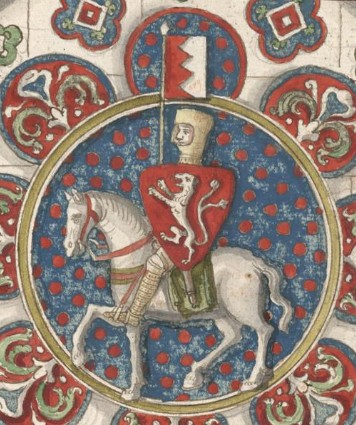Barons led by Simon de Montfort, 6th Earl of Leicester, press their call for reform in the field. The reign of Henry III was increasingly difficult for the English nobility to bear: Henry had begun his rule as a minor child under a regency, but as an adult proved to be a spendthrift and an incompetent, losing what was left of the Angevin Empire in France, engaging in a guerrilla war with Wales, and refuting the Magna Carta in 1232, before engaging in an expensive and foolish plan to make his brother Holy Roman Emperor, and his younger son king of Sicily. The leader of the resistance was the king’s brother-in-law, Simon de Montfort, Earl of Leicester, a noted soldier and crusader who had been undercut in Gascony by Henry’s favorites. In 1258, Parliament met at Oxford, armed and demanding a say in revenue spending and a redress of grievances, such as the violation of London’s charter. In 1259, Henry III signed the Provisions of Westminster, guaranteeing court reform and representation, but by 1260 the barons were quarrelling and the king, prompted by his son, Edward, went to the French to intervene.
De Montfort led an army through England in response to the king’s voiding of the Westminster agreement, and on 12 May 1264 caught the royal army at Lewes, where he routed them, after Prince Edward had left the field to chase a party of infantry. Unusually for the time, de Montfort deployed his army so that he had a “fourth” left in reserve. Now in control of the king and the country, de Montfort braced for an attack from France, and held a parliament in January 1265, which demanded that two knights from each shire be called regularly to advise the king and monitor spending.
Despite an alliance with the prince of Wales, de Montfort could not hold up against the defection of Gilbert de Clare to the king, nor the growing party of Prince Edward, who successfully kept the barons’ forces away from supplies and reinforcement at Kenilworth. Moving to relieve them, de Montfort, probably exhausted, allowed himself to be trapped at Evesham, where, on 3 August 1265, he and his army were massacred by troops led by Prince Edward. After 1265, Edward, the future Edward I, ruled as acting king for his father, and repudiated the concessions made to the barons. Nonetheless, by 1267 he had approved the Statutes of Marlborough, which legalized reform along the lines of the baron’s campaign, and Parliament began to meet regularly. Despite his defeat in the field, Simon de Montfort eventually became the father of the English Parliament and of representative government.
#
Course of the war
The charismatic de Montfort and his forces had captured most of southeastern England by 1263 and at the Battle of Lewes in 1264, Henry was defeated and taken prisoner by de Montfort’s army. While Henry was reduced to a figurehead king, de Montfort broadened representation to include each county of England and many important towns – i.e. to groups beyond the nobility. Henry and Edward continued under house arrest. The short period which followed was the closest England was to come to complete abolition of the monarchy until the Commonwealth period of 1649–1660, and many of the barons who had initially supported de Montfort began to suspect that he had gone too far with his reforming zeal.
Only fifteen months later de Montfort’s gains were reversed when Edward Longshanks escaped captivity to lead the royalists into battle again, defeating and killing de Montfort at the Battle of Evesham in 1265. His son, Simon, attempted a negotiated surrender but it was rejected by de Montfort loyalists. The impasse culminated in the six month Siege of Kenilworth at which the King prevailed. de Montfort’s forces were permitted to leave the castle with their weapons and horses.
Following this victory, savage retribution was exacted on the rebels and authority was restored to King Henry. The casualties of the war are estimated at 15,000.
Timeline
* 1261 – King Henry III of England obtains a papal bull releasing him from the Provisions of Oxford
* 1264 – Before May – The war officially begins.
* 1264 – May 14 – The Battle of Lewes is fought between Simon de Montfort, 6th Earl of Leicester and King Henry III of England in Sussex. By the end of the battle, de Montfort’s forces capture both King Henry and his son, future King Edward I, making de Montfort the “uncrowned king of England”.
* 1265 – January 20 – In Westminster, the first English parliament conducts its first meeting in the Palace of Westminster, now also known as the Houses of Parliament.
* 1265 – May 28 – Future King Edward I of England escapes captivity at the hands of Simon de Montfort, 6th Earl of Leicester.
* 1265 – August 4 – The Battle of Evesham is fought in Worcestershire, with the army of Edward defeating the forces of rebellious barons led by Simon de Montfort and killing de Montfort and many of his allies.
* 1266 – October – The war winds down as supporters of the slain Simon de Montfort make an offer of peace to the king in the Dictum of Kenilworth.
* 1267 – The war ends, as the rebels and King Henry III of England agree to peace terms as laid out in the Dictum of Kenilworth.
